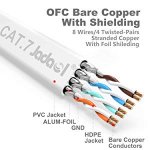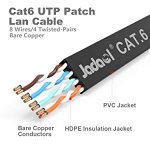Hi
I have been using an old router as a network switch for the past few years and changing it over to a TP-Link TL-SG1005D and looking to upgrade my Ethernet cables.
I currently have a round cat6 coming from my router downstairs to the switch in the hall upstairs (I've just pinned the wire around the skirting and up the staircase) and noticed one of my ethernet cables from the switch to my PC has frayed so need to replace it, I was looking online for cat6 cables and seen you can get flat ethernet cables and wondered if they were any good or if I should stick to the round ones?
I need to put an ethernet cable into 2 other rooms from the switch and these flat ones would save me the hassle of pinning them to the wall as I could just run them under the carpet for the short 4 Meters they would be going to the tvs/sky box on the rooms.
Whats your thoughts on them, are they just as good and would running them under the carpet be ok/safe?
Ta
JJ
I have been using an old router as a network switch for the past few years and changing it over to a TP-Link TL-SG1005D and looking to upgrade my Ethernet cables.
I currently have a round cat6 coming from my router downstairs to the switch in the hall upstairs (I've just pinned the wire around the skirting and up the staircase) and noticed one of my ethernet cables from the switch to my PC has frayed so need to replace it, I was looking online for cat6 cables and seen you can get flat ethernet cables and wondered if they were any good or if I should stick to the round ones?
I need to put an ethernet cable into 2 other rooms from the switch and these flat ones would save me the hassle of pinning them to the wall as I could just run them under the carpet for the short 4 Meters they would be going to the tvs/sky box on the rooms.
Whats your thoughts on them, are they just as good and would running them under the carpet be ok/safe?
Ta
JJ
Last edited:



